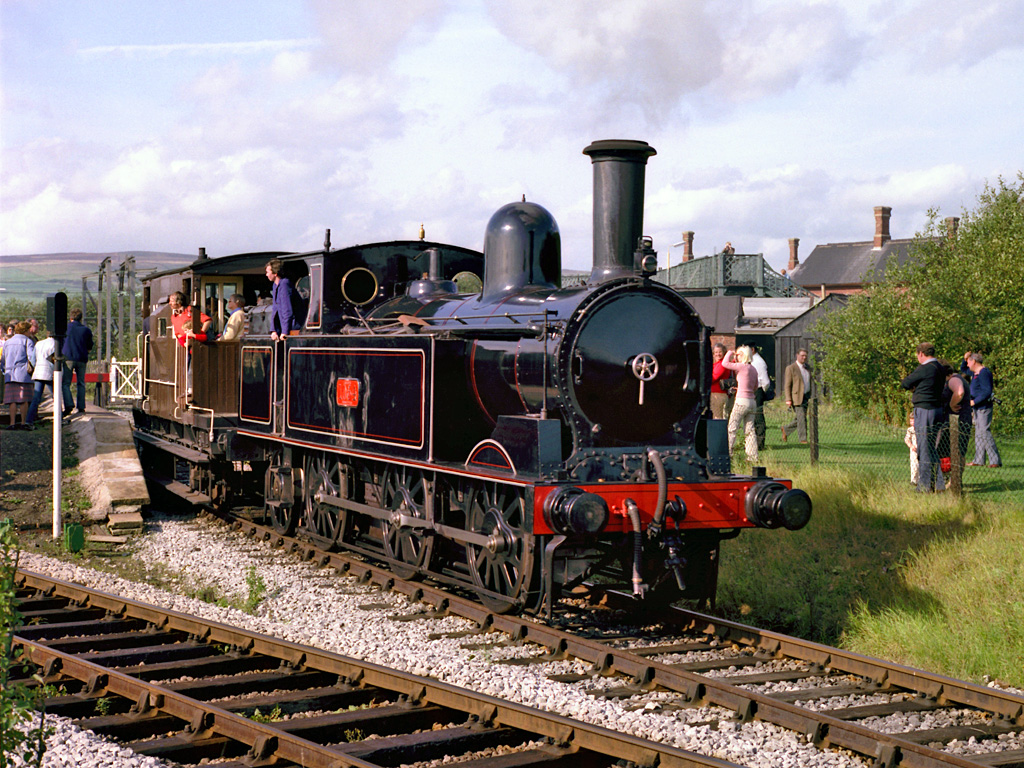LNWR Webb Coal Tank on:
[Wikipedia]
[Google]
[Amazon]
The

 One Coal Tank number BR 58926, ex-LMS 7799, originally LNWR 1054, the 250th one built, has survived in preservation on the
One Coal Tank number BR 58926, ex-LMS 7799, originally LNWR 1054, the 250th one built, has survived in preservation on the
Goods Engines of LNWR
0-6-2T locomotives Webb Coal Tank Railway locomotives introduced in 1881 Standard-gauge steam locomotives of Great Britain C1′ n2t locomotives Freight locomotives {{UK-steam-loco-stub
London and North Western Railway
The London and North Western Railway (LNWR, L&NWR) was a British railway company between 1846 and 1922. In the late 19th century, the LNWR was the largest joint stock company in the world.
Dubbed the "Premier Line", the LNWR's main line connec ...
(LNWR) Webb Coal Tank is a class of 0-6-2T
T, or t, is the twentieth letter of the Latin alphabet, used in the modern English alphabet, the alphabets of other western European languages and others worldwide. Its name in English is ''tee'' (pronounced ), plural ''tees''.
It is d ...
steam locomotive. They were called "Coal Tanks" because they were a side tank
Side or Sides may refer to:
Geometry
* Edge (geometry) of a polygon (two-dimensional shape)
* Face (geometry) of a polyhedron (three-dimensional shape)
Places
* Side, Turkey, a city in Turkey
* Side (Ainis), a town of Ainis, ancient Thessaly, Gr ...
version of Webb's standard LNWR 17in Coal Engine, an 0-6-0
is the Whyte notation designation for steam locomotives with a wheel arrangement of no leading wheels, six powered and coupled driving wheels on three axles, and no trailing wheels. Historically, this was the most common wheel arrangement used o ...
tender engine for slow freight trains.
Design
The design was introduced in 1881 by F.W. Webb and had the same cheaply producedcast iron
Cast iron is a class of iron–carbon alloys with a carbon content of more than 2% and silicon content around 1–3%. Its usefulness derives from its relatively low melting temperature. The alloying elements determine the form in which its car ...
wheels and H-section spokes as the tender engines. A trailing radial axle A radial axle is an axle on a railway locomotive or carriage which has been designed to move laterally, along the arc of a circle, when entering a curve to reduce the flange and rail wear. William Bridges Adams was an early developer of radial axles ...
supporting the bunker
A bunker is a defensive military fortification designed to protect people and valued materials from falling bombs, artillery, or other attacks. Bunkers are almost always underground, in contrast to blockhouses which are mostly above ground. T ...
was added also with two similarly cast iron wheels. Three hundred were built between 1881 and 1897.
Operational history
Four (LNWR nos. 178, 484, 1257, 69) were withdrawn in January–February 1920 and a further four (LNWR nos. 142, 994, 782, 1012) in July and November 1922, so at the 1923grouping
Grouping generally refers to the creation of one or more groups, or to the groups themselves.
More specifically, grouping may refer to:
* Shot grouping in shooting sports and other uses of firearms
* the use of symbols of grouping in mathemati ...
, 292 passed to the London Midland and Scottish Railway
The London, Midland and Scottish Railway (LMSIt has been argued that the initials LMSR should be used to be consistent with LNER, GWR and SR. The London, Midland and Scottish Railway's corporate image used LMS, and this is what is generally ...
(LMS). They were renumbered from the LNWR's random allocation based on vacant numbers, to a solid block sequence 7550–7841, and given the power classification 1F. Many locomotives still in service in 1934 were renumbered by the addition of 20,000 to their number.
Sixty-four locomotives passed into British Railways
British Railways (BR), which from 1965 traded as British Rail, was a state-owned company that operated most rail transport in Great Britain from 1948 to 1997. Originally a trading brand of the Railway Executive of the British Transport Commis ...
ownership in January 1948 and they were numbered 58880–58937, but not all examples survived long enough to carry their BR numbers.
Preservation

 One Coal Tank number BR 58926, ex-LMS 7799, originally LNWR 1054, the 250th one built, has survived in preservation on the
One Coal Tank number BR 58926, ex-LMS 7799, originally LNWR 1054, the 250th one built, has survived in preservation on the Keighley and Worth Valley Railway
The Keighley & Worth Valley Railway (KWVR) is a heritage railway in the Worth Valley, West Yorkshire, England, which runs from Keighley to Oxenhope. It connects to the National Rail network at Keighley railway station.
History Inception an ...
, normally carrying its LNWR livery and number. The locomotive is owned by the National Trust
The National Trust () is a heritage and nature conservation charity and membership organisation in England, Wales and Northern Ireland.
The Trust was founded in 1895 by Octavia Hill, Sir Robert Hunter and Hardwicke Rawnsley to "promote the ...
and is maintained and run by the Bahamas Locomotive Society.
In February 2024, the National Trust handed ownership of 1054 to the Bahamas Locomotive Society and will remain based at Ingrow West on the Keighley and Worth Valley Railway.
Models
Bachmann Branchline released a model of the coal tanks in 2017. The three variants released were: -LNWR Black 1054 (As preserved) -LMS Black 7841 -BR Black early emblem 58900 So far, these are the only variants in production with no other liveries announced.Notes
References
* *External links
Goods Engines of LNWR
0-6-2T locomotives Webb Coal Tank Railway locomotives introduced in 1881 Standard-gauge steam locomotives of Great Britain C1′ n2t locomotives Freight locomotives {{UK-steam-loco-stub